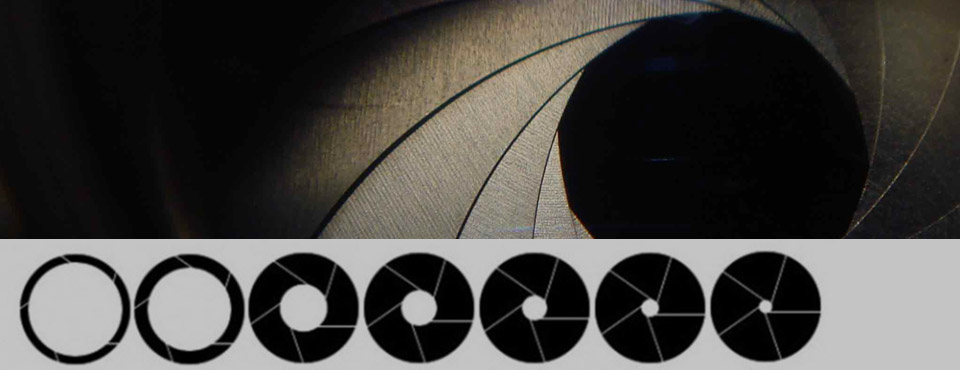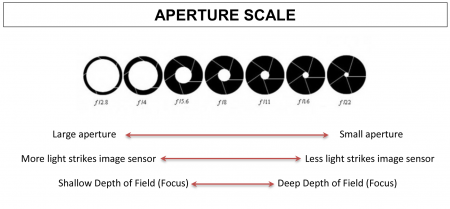Aperture. Iris. F Stops. T Stops. Light Meters. Histograms… A lot of people don’t know enough about these topics and of course, the more you know – the better you can craft your images.
One of the first things that people think of when talking about f stops is depth of field and that’s fine. A wide open lens is going to give you the shallowest dept of field possible for your lens and stopping down the lens is going give you a wider depth of field. The faster the lens – the more you can open it up. There are tons of cell phone apps, online calculators and charts available – so I’m not going to harp on this subject too much. DOFMaster has a very versatile one that applies to pretty much every single DSLR under the sun. RED Digital Cinema has one that has a lot of presets ready to go for shooting on RED and their various aspect ratios and resolutions. For Android phones and tablets, I’m a fan of CamCalc Free which in addition to DoF calculations, also provides Field of View, Focal Length Equivalents, Exposure Compensation and more.
The primary thing I want to discuss in this entry however is the mathematics of what each increment f stop means in relation to light.
Each f stop is either twice the amount of light (opening up 1 stop) or half the amount of light (stopping down 1 stop).
So with the standard range of f stops being 1.4 – 2.0 – 2.8 – 4.0 – 5.6 – 8 – 11 – 16 – 22, a lower end lens with a minimum aperture of f4.0 is at best going to allow in 1/4 the amount of f2.0 lens wide open. Taking it one step further, we’ll do a translation using f2.0 lenses as a benchmark:
f2.0 is 2x the light of f2.8
f2.0 is 4x the light of f4.0
f2.0 is 8x the light of f5.6
f2.0 is 16x the light of f8.0
f2.0 is 32x the light of f11
f2.0 is 64x the light of f16
f2.0 is 128x the light of f22
When looking into lens purchases, this will help to make sense of wha you’re looking at and paying for. If you’re looking at a telephoto lens – there’s a massive difference between f2.8 and f5.6 – again the f2.8 is letting in four times the amount of light. This is why superspeed primes cost what they do. There’s a lot of engineering that comes into play to manufacture lenses that produce a quality image and let in that amount of light.
As a standard, almost every zoom lens or variable prime out there is f2.8. There are obvious benefits to being able to change your focal length without swapping lenses, recalibrating follow focus, adjusting matteboxes, etc – but the cost is often the loss of light. I was on a shoot last week that required a whip zoom on my RED 18-50mm variable prime and therefore prohibited the use of my 1.4 superspeed lens that I had at the ready. In that instance, we could have really used the 4x light intake from a superspeed for some of the darker scenes. This is something to know, internalize, and have on the tip of your tongue when discussing your lens choices for a scene and what you need to do to properly light the scene.
And for those unfamiliar with T stops, here’s a quick blurb grabbed from wikipedia:
“A T-stop (for Transmission-stops) is an f-number adjusted to account for light transmission efficiency. A lens with a T-stop of N projects an image of the same brightness as an ideal lens with 100% transmission and an f-number of N. For example, an f/2.0 lens with light transmission efficiency of 75% has a T-stop of 2.3. Since real lenses have transmission efficiencies of less than 100%, a lens’s T-stop is always greater than its f-number.[6]
Lens light transmission efficiencies of 60%-90% are typical,[7] so T-stops are sometimes used instead of f-numbers to more accurately determine exposure, particularly when using external light meters.[8] T-stops are often used in cinematography, where many images are seen in rapid succession and even small changes in exposure will be noticeable. Cinema camera lenses are typically calibrated in T-stops instead of F-numbers. In still photography, without the need for rigorous consistency of all lenses and cameras used, slight differences in exposure are less important.”
In a future blog, I’ll be going over some light meter stuff help you pre-light and keep your exposure on the up and up. Until then, happy shooting!


